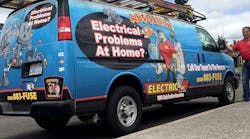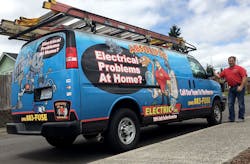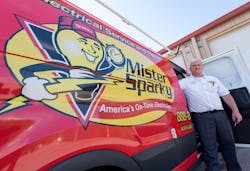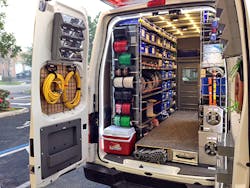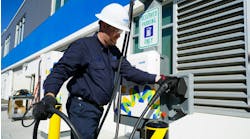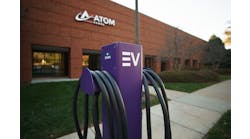When an electrical contractor is racing against the clock to provide timely service to customers, every minute counts. As such, many contractors are equipping their electricians with a fully stocked “warehouse on wheels.”
For example, Harrison Electric’s technicians used to bend over and crawl inside their service vans to search for a buried part. Fifteen years later, the company’s eight technicians can walk upright inside a box truck organized like a hardware store.
“It’s much safer for our technicians and cuts down on work-related injuries,” says Jon Harrison, a master electrician and owner of Plymouth, Minn.-based Harrison Electric. “Also, it allows them to carry what they need, and the parts are readily available.”
Equipping electricians with well-organized work vehicles is essential in today’s marketplace, says Chris Crew, manager and co-owner of four Mister Sparky Florida franchises. Twenty years ago (when he first entered the electrical trade), he worked out of a pickup truck — and was responsible for stocking his own vehicle with material from the warehouse. Craving organization, Crew stored the parts in empty 2-gallon buckets and labeled each container. For example, he threaded a section of wire through the lid of a bucket of connectors.
“My job was to open the buckets each day, see how many were missing, and then restock them,” says Crew, a master electrician in the state of Florida. “It was not a very consistent way of doing things, and no truck was exactly the same. As a result, if my truck was in the shop, it was a nightmare to work that day without it.”
Fast-forward to today, and Crew and his partner now manage 43 electricians in Tampa, Sarasota, Fort Meyers, and Pompano Beach, Fla. He says not having a properly stocked vehicle cuts into a contractor’s productivity and billable hours.
“Customers are getting very comfortable in the fact that people who charge by the hour are going to charge a flat price to do a job,” Crew says. “It doesn’t matter how many trips it takes an electrician to go back to their truck or a supply house to get a part. You’re not going to make money when your electricians are doing unproductive tasks.”
Organizing a work truck
By setting up each work vehicle the same way, electrical contractors can improve their electricians’ efficiency. For example, when Crew and his partner purchased their franchises, they also bought vans equipped with a franchise-standard shelving package.
“No matter who drives that van, the part is in the same place,” Crew says. “For example, if you drive truck number 109 or 136, the trucks will be exactly the same when you get inside of them.”
In the company’s service vans, electrical parts are organized in numerical and alphabetical order within plastic bins, each of which includes a list of what’s inside of it as well as the quantity of each item, so electricians know exactly how to find each part. The parts are also grouped together in similar types and colors. For example, all the white receptacle covers are stored in the same bin.
Each van includes a variety of parts, including multiple brands and styles of circuit breakers; receptacles; switches; screws, wire nuts, and connectors; electrical panels; wire; smoke detectors; surge protectors; and lamps. In addition, the electricians stock other work-specific items, such as lubricant, insect spray, ladders, pipe benders, drills, drop cords, and drop lights.
Harrison Electric also has an organized system to its work vehicles. Over the years, the company redesigned its eight box trucks inside and out. Inside the trucks, Harrison Electric fully customized the shelving with slide-out bins and trays, which can be divided to carry the necessary parts. Each of the trucks is a near-copy of all the others so the company can easily flip installers from vehicle to vehicle.
“They don’t need to re-learn where stuff is,” Harrison says. “When our apprentices and helpers work on a job, if they know one truck, they know all eight. It helps to manage our materials and inventory.”
For example, the electricians stock their trucks with everything they need to successfully complete a residential service call lasting about two or three hours. Inside their box trucks, the electricians can easily find a variety of receptacles, dimmers, service equipment for emergency repairs, service panels, and circuit breakers.
“If it’s material that will go into a house, we will carry some level of it to be able to get through service calls,” Harrison says. “It gives our electricians the confidence to go straight to a job because they know they will have what they need to get started.”
If the electrician needs a unique part, the company will courier the product directly from the distributor to the job site. Because they have the general parts they need to get started, however, the electricians can stay in front of the customer rather than disappearing for an hour-long trip to a local store.
“It’s a win-win for the customer,” Harrison says. “They are not paying for unforeseen windshield time, and because they see how much our installers are involved with them, it makes us look efficient in their eyes.”
Harrison says organizing the box trucks has saved labor hours and increased the electricians’ productivity. Case in point: If each of its eight electricians wasted 15 minutes a day looking for parts, then the company would lose about a week-and-a-half a year.
“The parts should be readily accessible,” Harrison says. “If you spend an hour trip to get something you should already have, then you will not recover that hour.”
Miami Electric Masters’ four service vans are also well organized. If you look inside of them, you will find a very clean stock room on wheels, says Andrew Caulder, chief operations officer for the Miami-based company.
“Basically, it has everything you would need for residential and commercial service from wire to fixtures to ground rods and lamps,” Caulder says. “Our trucks include tools for almost any job our electricians would encounter.”
To keep the vans organized, Miami Electric Masters uses bins, bungee cords, and retail packaging.
“A competitor will buy in bulk, but it is hard to keep those things organized,” he says. “We buy in retail packaging to keep everything clean, neat, and organized,” Caulder says. “If you save time, you save money.”
Training electricians
While service contractors aim for the highest level of organization possible within their vehicles, they also know that this won’t happen overnight without some training. For example, before WireMaster Electric gives an electrician his or her own truck, the technician must engage in an onboarding and mentorship program.
Recently hired technicians ride along with seasoned electricians to learn how to safely operate a service truck and handle customers. For example, the veteran employee will teach the newcomer about correct vehicle placement so they don’t block a customer’s car. Also, they learn how to stand at the door, speak to the customer, and clearly communicate.
Harrison says his company also trains each of its eight technicians on how to organize the tools and materials.
“We specify what goes in which bin, and if it’s not on the list, then it shouldn’t be on the truck,” Harrison says. “Rather than having hordes and hordes of the same part, we have a variety of parts on our trucks.”
Investing in mobile technology
While the electricians often store spare parts and tools in the back of their trucks and vans, the cabs include the latest mobile technology. In the past, service contractors had to wrangle with paper maps and brick-sized cell phones. Today, electricians don’t pull out of the driveway without an arsenal of mobile technology — from laptops to tablets to smart phones to GPS units.
For example, the electricians for Miami Electric Masters use iPads for every step of the process. First, they receive their dispatch orders. Then they log their arrival time, collect payment, and input data about the job all on their personal iPads.
To protect the tablets, the contractor invested in a ruggedized case for each device. Furthermore, Miami Electric Masters equipped its service vans with specialized mounts within the cab of the truck so the electricians can use the iPads for navigation.
If necessary, electricians can place critical documents in a designated bin inside the cab. Since the contractor has moved to a paperless system, however, the mobile technology becomes even more important.
At Harrison Electric, the technicians not only rely upon smartphones for verbal communication, but also for the high-quality cameras within them. These cameras allow them to snap photos of an odd electrical part, and then the office staff can look for it online. They can also email the technicians a photo of an invoice if they don’t have the original paperwork on hand.
Improving safety
When designing its vans, Miami Electric Masters focused not only on organization, but also on safety. Its electricians take turns working the on-call shift, during which a call for help could come in the middle of the night. To this end, Miami Electric Masters included special LED lights throughout the cab and the work area of the truck. In addition, the electricians can use mobile lanterns to illuminate the ground surrounding the truck.
Mister Sparky’s new vehicles also illuminate the interior with LED lights. Additionally, the company invested in a fleet management software system to ensure the safety of its electricians on the road. Crew says his franchise hard-wired GPS into the vehicles to not only give the electricians directions to their next job, but also to keep tabs on their driving record.
“If our people are driving recklessly, then it creates a lot of exposure for our company, and we want to know about it,” Crew says. “When someone is speeding, doing fast takeoffs, turning corners sharply, or braking quickly, it will send out an alert to the appropriate manager and include this in a monthly driving report.”
Meanwhile, Harrison Electric technicians rely on permanently mounted GPS units. The GPS units have replaced paper-based maps, which the technicians used to rely upon to look up addresses and draw up routes, says Harrison, who has served in the electrical industry for the last 30 years.
“The GPS offers a safer route because you are told before you need to be there what turns you need to take,” Harrison says. “It makes for a safer driver, it saves time, and it leads to a safer fleet.”
By equipping work vehicles with the latest mobile technology, as well as the proper materials and tools, electrical contracting firms can boost their bottom line along with the productivity of their employees.
“In this day and age, all assets on your balance sheet should be making you money,” Crew says. “Oftentimes, businesses are very front loaded on vehicles and while they have plenty of them, they don’t stock them correctly — providing a disservice to their customers for their inefficiencies.”
On the flip side, however, Crew says a well-organized work vehicle can improve productivity.
“If our electricians don’t have to dig around on the truck to find a gadget or widget, it translates into more time for them to turn a wrench and do the work,” Crew says. “It makes them more productive.”
Fischbach is a freelance writer based in Overland Park, Kansas. She can be reached at [email protected].
SIDEBAR: Five Ways to Transform Your Service Van into a Warehouse on Wheels
Larry Warner, president and owner of Absolute Electric, Inc., in Vancouver, Wash., shifted the focus of his business from new construction to service work 12 years ago. After 20 years in the electrical industry, he has learned how to set up a service van for maximum efficiency. Here are a few of his tricks of the trade for organization.
- Stock a diverse and complete inventory. Warner drives a one-ton van complete with more than 600 line items. He says he’s a rarity in his area as far as the number of products on his van. “I like having everything on my van, and I don’t like going to the store to get a part,” Warner says. “That saves the homeowner’s time, and allows me to build a relationship with them and do whatever I need to do to get the job done without feeling rushed.”
- Designate a home for every item. To customize the bins and racks within the service van, Warner worked with a manufacturer, which ensured that each part had a designated spot.
- Configure an efficient layout. As Warner looks to expand his business by hiring another journeyman electrician, he is looking for ways to make his second van even more efficient. For example, he is placing frequently used items in a readily accessible location and those items not used as often in the middle of the van.
- Be prepared for anything and everything. In new construction, Warner didn’t need to carry different brands of circuit breakers, vacuum cleaners, and special tools. But now that he is focusing solely on service work, he ensures that he not only stocks the traditional products, but also “oddball, once-in-a-blue-moon” items. For example, he stocks pull chains for fixtures as well as “flying saucers” for heaters within bathrooms.
- Replenish your stock. At the end of each work day, Warner checks to see what items were pulled off of his truck, and then he immediately orders them so they are ready to re-stock on the truck for the next work day.
